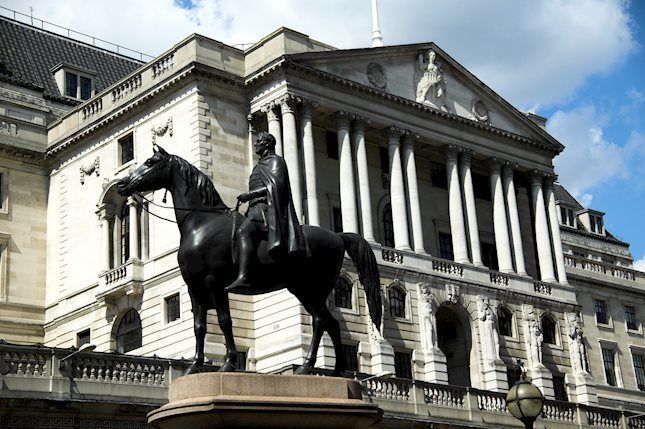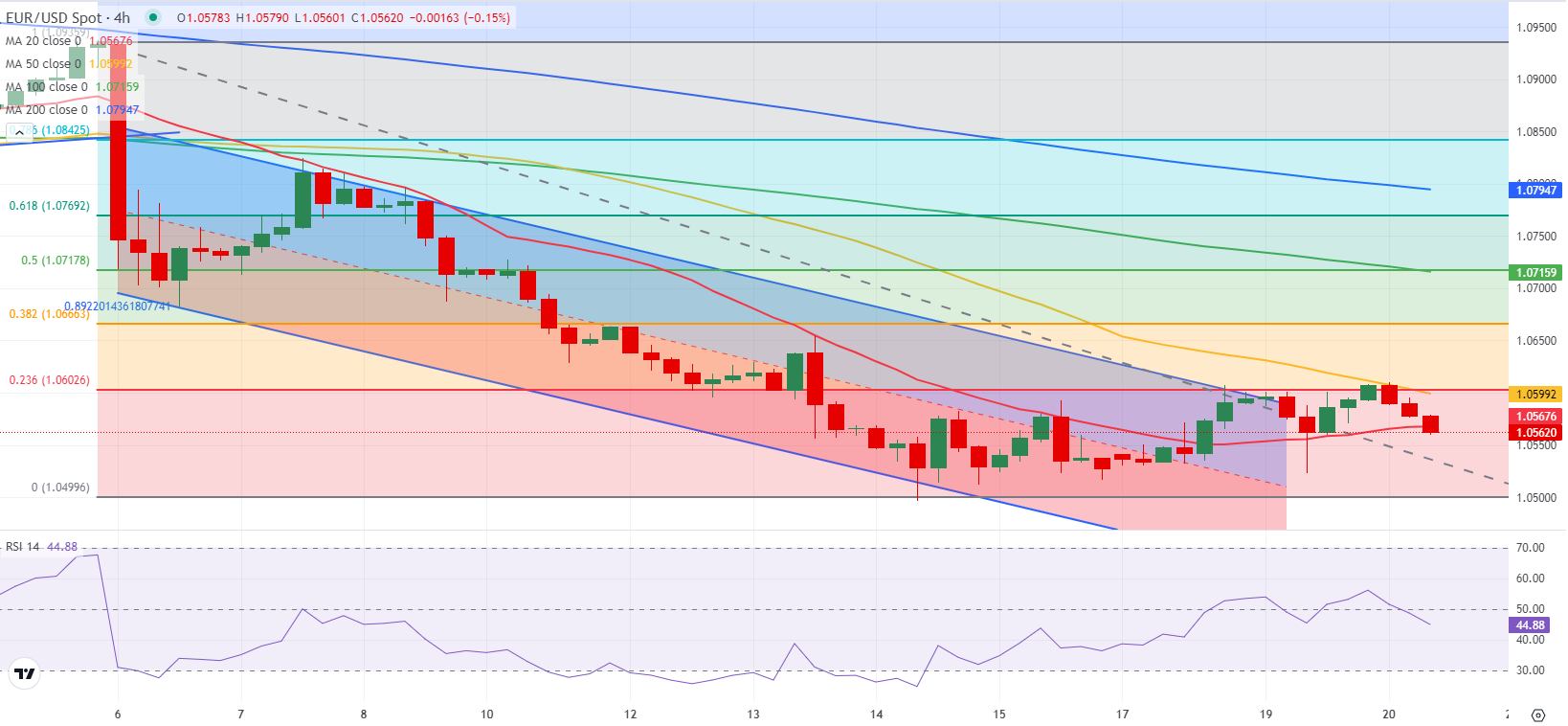- EUR/USD trades below 1.0600 in the European session on Wednesday.
- The ECB will release Negotiated Wage Rates data for the third quarter.
- The technical outlook points to a bearish tilt in the near term.
After falling toward 1.0520 in the European session on Tuesday, EUR/USD staged a rebound and closed the day virtually unchanged. The pair, however, lost its traction after meeting resistance near 1.0600 and started to edge lower toward 1.0550.
Euro PRICE This week
The table below shows the percentage change of Euro (EUR) against listed major currencies this week. Euro was the weakest against the Canadian Dollar.
| USD | EUR | GBP | JPY | CAD | AUD | NZD | CHF | |
|---|---|---|---|---|---|---|---|---|
| USD | -0.21% | -0.43% | 0.93% | -0.82% | -0.81% | -0.36% | -0.39% | |
| EUR | 0.21% | -0.05% | 1.25% | -0.50% | -0.46% | -0.03% | -0.07% | |
| GBP | 0.43% | 0.05% | 1.32% | -0.45% | -0.41% | 0.02% | -0.02% | |
| JPY | -0.93% | -1.25% | -1.32% | -1.74% | -1.66% | -1.21% | -1.24% | |
| CAD | 0.82% | 0.50% | 0.45% | 1.74% | 0.03% | 0.46% | 0.43% | |
| AUD | 0.81% | 0.46% | 0.41% | 1.66% | -0.03% | 0.43% | 0.39% | |
| NZD | 0.36% | 0.03% | -0.02% | 1.21% | -0.46% | -0.43% | -0.03% | |
| CHF | 0.39% | 0.07% | 0.02% | 1.24% | -0.43% | -0.39% | 0.03% |
The heat map shows percentage changes of major currencies against each other. The base currency is picked from the left column, while the quote currency is picked from the top row. For example, if you pick the Euro from the left column and move along the horizontal line to the US Dollar, the percentage change displayed in the box will represent EUR (base)/USD (quote).
The pullback seen in the US Treasury bond yields made it difficult for the US Dollar (USD) to gather strength on Tuesday and helped EUR/USD find a foothold. Nevertheless, the risk-averse market atmosphere on a further escalation of the Russia-Ukraine conflict didn't allow the pair to extend its recovery.
Later in the session, the European Central Bank (ECB) will release the Negotiated Wage Rates data for the third quarter. In the second quarter, this data came in at 3.53%. A bigger increase in Q3 could help the Euro stay resilient against its major rivals with the immediate reaction. Additionally, ECB President Christine Lagarde will deliver a welcome address at the ECB Conference on Financial Stability and Macroprudential Policy in Frankfurt, Germany.
In the absence of high-tier data releases, the risk perception could drive EUR/USD's action in the second half of the day. At the time of press, US stock index futures were up between 0.2% and 0.3%. A bullish opening in Wall Street could limit the USD's gains but investors could refrain from moving towards risk-sensitive assets amid the uncertainty surrounding geopolitics.
EUR/USD Technical Analysis
The Relative Strength Index (RSI) indicator on the 4-hour chart retreated below 50, reflecting a lack of buyer interest. On the downside, immediate support is located at 1.0550 (static level) before 1.0500 (round level).
In case EUR/USD rises above 1.0600 (50-period Simple Moving Average (SMA), Fibonacci 23.6% retracement of the latest downtrend), it could meet next resistances at 1.0670 (Fibonacci 38.2% retracement) and 1.0715-1.0720 (100-period SMA, Fibonacci 50% retracement).
Euro FAQs
The Euro is the currency for the 19 European Union countries that belong to the Eurozone. It is the second most heavily traded currency in the world behind the US Dollar. In 2022, it accounted for 31% of all foreign exchange transactions, with an average daily turnover of over $2.2 trillion a day. EUR/USD is the most heavily traded currency pair in the world, accounting for an estimated 30% off all transactions, followed by EUR/JPY (4%), EUR/GBP (3%) and EUR/AUD (2%).
The European Central Bank (ECB) in Frankfurt, Germany, is the reserve bank for the Eurozone. The ECB sets interest rates and manages monetary policy. The ECB’s primary mandate is to maintain price stability, which means either controlling inflation or stimulating growth. Its primary tool is the raising or lowering of interest rates. Relatively high interest rates – or the expectation of higher rates – will usually benefit the Euro and vice versa. The ECB Governing Council makes monetary policy decisions at meetings held eight times a year. Decisions are made by heads of the Eurozone national banks and six permanent members, including the President of the ECB, Christine Lagarde.
Eurozone inflation data, measured by the Harmonized Index of Consumer Prices (HICP), is an important econometric for the Euro. If inflation rises more than expected, especially if above the ECB’s 2% target, it obliges the ECB to raise interest rates to bring it back under control. Relatively high interest rates compared to its counterparts will usually benefit the Euro, as it makes the region more attractive as a place for global investors to park their money.
Data releases gauge the health of the economy and can impact on the Euro. Indicators such as GDP, Manufacturing and Services PMIs, employment, and consumer sentiment surveys can all influence the direction of the single currency. A strong economy is good for the Euro. Not only does it attract more foreign investment but it may encourage the ECB to put up interest rates, which will directly strengthen the Euro. Otherwise, if economic data is weak, the Euro is likely to fall. Economic data for the four largest economies in the euro area (Germany, France, Italy and Spain) are especially significant, as they account for 75% of the Eurozone’s economy.
Another significant data release for the Euro is the Trade Balance. This indicator measures the difference between what a country earns from its exports and what it spends on imports over a given period. If a country produces highly sought after exports then its currency will gain in value purely from the extra demand created from foreign buyers seeking to purchase these goods. Therefore, a positive net Trade Balance strengthens a currency and vice versa for a negative balance.
Information on these pages contains forward-looking statements that involve risks and uncertainties. Markets and instruments profiled on this page are for informational purposes only and should not in any way come across as a recommendation to buy or sell in these assets. You should do your own thorough research before making any investment decisions. FXStreet does not in any way guarantee that this information is free from mistakes, errors, or material misstatements. It also does not guarantee that this information is of a timely nature. Investing in Open Markets involves a great deal of risk, including the loss of all or a portion of your investment, as well as emotional distress. All risks, losses and costs associated with investing, including total loss of principal, are your responsibility. The views and opinions expressed in this article are those of the authors and do not necessarily reflect the official policy or position of FXStreet nor its advertisers. The author will not be held responsible for information that is found at the end of links posted on this page.
If not otherwise explicitly mentioned in the body of the article, at the time of writing, the author has no position in any stock mentioned in this article and no business relationship with any company mentioned. The author has not received compensation for writing this article, other than from FXStreet.
FXStreet and the author do not provide personalized recommendations. The author makes no representations as to the accuracy, completeness, or suitability of this information. FXStreet and the author will not be liable for any errors, omissions or any losses, injuries or damages arising from this information and its display or use. Errors and omissions excepted.
The author and FXStreet are not registered investment advisors and nothing in this article is intended to be investment advice.
Recommended Content
Editors’ Picks

EUR/USD extends losses to 1.0550 after ECB Negotiated Wages data
EUR/USD holds lower ground near 1.0550 in European trading on Wednesday. The US Dollar resurgence alongside the US Treasury bond yields higher weighs on the pair. Meanwhile, ECB reported Negotiated Wage Rates rose 5.42% in Q3 but this data failed to support the euro.

GBP/USD reverses toward 1.2650, erases UK CPI-led gains
GBP/USD is falling back toward 1.2650 in the European session on Wednesday, having erased UK CPI inflation-data-led gains. The data from the UK showed that the annual inflation, as measured by the change in the CPI, rose to 2.3% in October from 1.7% in September. Fedspeak awaited.

Gold price moves away from one-week top on rising US bond yields, modest USD strength
Gold price retreats after touching a one-and-half-week top earlier this Wednesday and drops to a fresh daily low, below the $2,630 level heading into the European session. A goodish pickup in the US Treasury bond yields, bolstered by bets for a less aggressive policy easing by the Fed, revives the USD demand and undermines demand for the non-yielding yellow metal.

Why is Bitcoin performing better than Ethereum? ETH lags as BTC smashes new all-time high records
Bitcoin has outperformed Ethereum in the past two years, setting new highs while the top altcoin struggles to catch up with speed. Several experts exclusively revealed to FXStreet that Ethereum needs global recognition, a stronger narrative and increased on-chain activity for the tide to shift in its favor.

Sticky UK services inflation to keep BoE cutting gradually
Services inflation is set to bounce around 5% into the winter, while headline CPI could get close to 3% in January. That reduces the chance of a rate cut in December, but in the spring, we think there is still a good chance the Bank of England will accelerate its easing cycle.

Best Forex Brokers with Low Spreads
VERIFIED Low spreads are crucial for reducing trading costs. Explore top Forex brokers offering competitive spreads and high leverage. Compare options for EUR/USD, GBP/USD, USD/JPY, and Gold.
